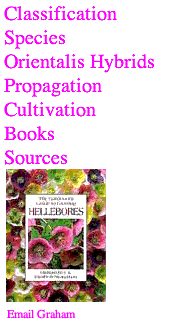

An expanded version of the article in The Garden (February 2001)
Orientalis Hybrids
This commonly used name covers hybrids between forms of H. orientalis, the Lenten rose, and any other species; however, wild species themselves are now less often used in breeding, most breeders preferring to work from existing hybrids which have already been refined in terms of colour and shape.
Most recent developments are derived from the plants created by the pioneering British hybridists Eric Smith, Jim Archibald then Elizabeth Strangman at Washfield Nursery and Helen Ballard. In Britain, John Massey and Philip Baulk at Ashwood Nurseries and Robin White at Blackthorn Nursery are now the leading breeders, having used stock from the pioneers and moved forward impressively. Will McLewin of Phedar Nurseries also works with these plants and more particularly with species while Graham Birkin of Graham’s Paradise Garden, Richard Bramley of Farmhouse Nurseries and Roger Harvey of Harvey’s Garden Plants, and are also serious breeders. Seed from German lists produced by Gisela Schmiemann, who took over Helen Ballard’s stock, and Marlene Ahlburg has also contributed to developments.
A number of enthusiasts from the United States have taken back carefully chosen plants from Britain which, in spite of having to be washed free of every speck of soil while in full flower, have allowed them to start with excellent stock. In the north west, where the climate is most similar to that in Britain, Glen Withey and Charles Price are improving both colour and shape, Dan Hinckley at Heronswood is creating his own colour strains, Elfie Rahr in Seattle is developing unusually vigorous plants, Northwest Garden Nursery sell a range of good quality plants derived from Gisela Schmiemann and Will McLewin seed, as well as from other breeders including working in the area.
Seed-raised strains, in separate colours, are becoming more widely available and this approach is also now being extended into double and anemone-flowered forms. Elizabeth Strangman was the pioneer of this approach, producing strains in a wide range of colours and at a quality far superior to many of the older, named clones still sought out by gardeners. Elizabeth has now retired and closed her nursery but she has arranged for her strains to be made more widely available in the future.
Other breeders continue in this way, each sale plant is derived from controlled hand pollination of carefully selected parents - the strain being constantly improved by the selection of superior parent plants.
In the single-flowered types, still seen by many as the best garden plants, refining flower shape, expanding the colour range and stabilising the colours have been the main objectives. A rounded, bowl-shaped form is still the most popular although Roger Harvey is working on a plants with a more starry flower form like ‘Bradfield Star’.
Some colours, especially the reds and yellows, are still in need of improvement, John Massey, for example, is developing a strain of superb yellows with golden nectaries. Newer colours like apricot are becoming popular and there is a growing demand for picotees, especially those with dark centres. Spotted types are amongst the most difficult to fix. Evenness of spotting across the five ‘petals’ is still the aim.
Breeding for flowers facing outward, or even upward, has been an aim of many breeders, hoping to improve the garden display and this feature, now becoming more constant in the best strains, is achieved, in effect, by selecting for short flower stems (peduncles). Elfi Rahr has had some success with this and has also developed the tallest and most robust plants I’ve seen. But generally this is a feature which varies from year to year and can be counterproductive in breeding terms as the flowers nod naturally to protect the reproductive parts from rain - upward facing flowers collect the rain. But most breeders aim for flowers which face outward.
Some nurseries take a more relaxed approach, simply collecting seed from good plants which have been bee-pollinated and giving them names like Royal Heritage, Ballards Strain or giving the name of a clone to seed collected from open pollinated plants. The results, however, can be highly unpredictable. So the best advice, unless you’re prepared to take a chance, is to visit a nursery and choose plants in flower.
Graham Birkin, though, has a different approach, hand pollinating to create predictable results then splitting the best plants for sale. Unfortunately for those of us in Britain, much of his stock is exported to the USA where it is providing material for a new generation of breeders.